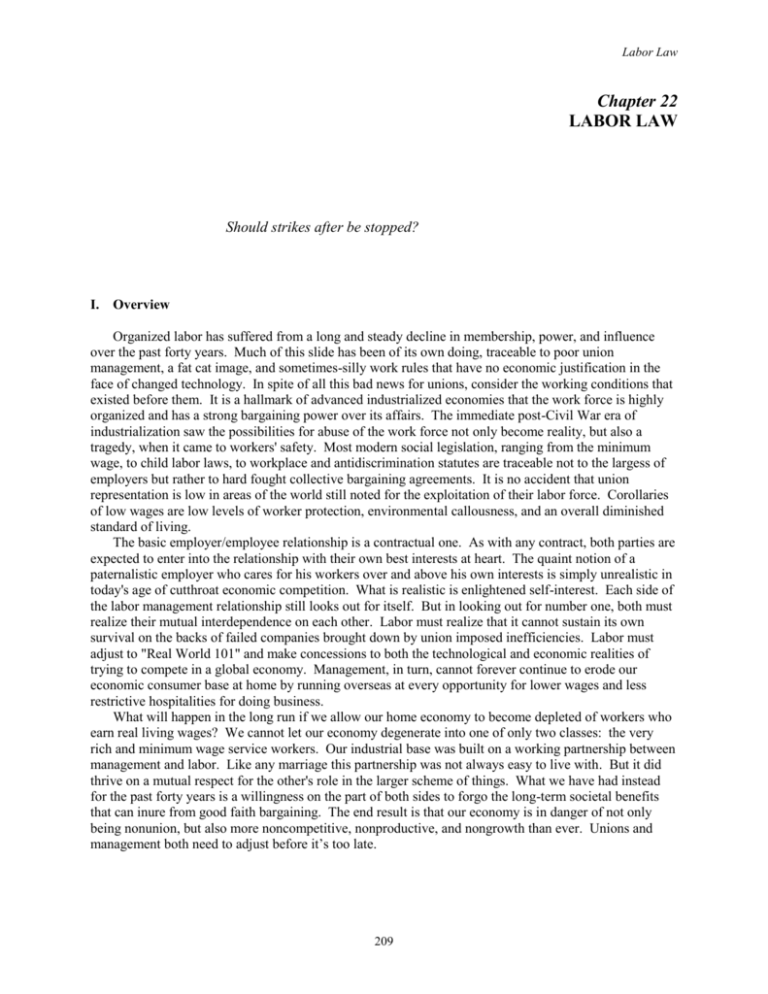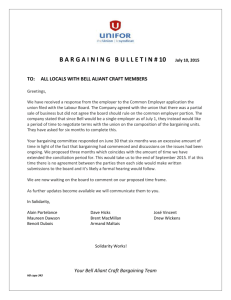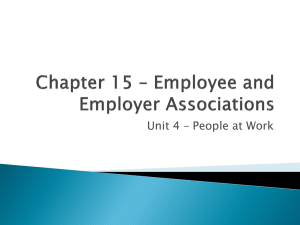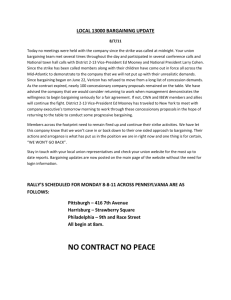Collective Bargaining
advertisement

Labor Law Chapter 22 LABOR LAW Should strikes after be stopped? I. Overview Organized labor has suffered from a long and steady decline in membership, power, and influence over the past forty years. Much of this slide has been of its own doing, traceable to poor union management, a fat cat image, and sometimes-silly work rules that have no economic justification in the face of changed technology. In spite of all this bad news for unions, consider the working conditions that existed before them. It is a hallmark of advanced industrialized economies that the work force is highly organized and has a strong bargaining power over its affairs. The immediate post-Civil War era of industrialization saw the possibilities for abuse of the work force not only become reality, but also a tragedy, when it came to workers' safety. Most modern social legislation, ranging from the minimum wage, to child labor laws, to workplace and antidiscrimination statutes are traceable not to the largess of employers but rather to hard fought collective bargaining agreements. It is no accident that union representation is low in areas of the world still noted for the exploitation of their labor force. Corollaries of low wages are low levels of worker protection, environmental callousness, and an overall diminished standard of living. The basic employer/employee relationship is a contractual one. As with any contract, both parties are expected to enter into the relationship with their own best interests at heart. The quaint notion of a paternalistic employer who cares for his workers over and above his own interests is simply unrealistic in today's age of cutthroat economic competition. What is realistic is enlightened self-interest. Each side of the labor management relationship still looks out for itself. But in looking out for number one, both must realize their mutual interdependence on each other. Labor must realize that it cannot sustain its own survival on the backs of failed companies brought down by union imposed inefficiencies. Labor must adjust to "Real World 101" and make concessions to both the technological and economic realities of trying to compete in a global economy. Management, in turn, cannot forever continue to erode our economic consumer base at home by running overseas at every opportunity for lower wages and less restrictive hospitalities for doing business. What will happen in the long run if we allow our home economy to become depleted of workers who earn real living wages? We cannot let our economy degenerate into one of only two classes: the very rich and minimum wage service workers. Our industrial base was built on a working partnership between management and labor. Like any marriage this partnership was not always easy to live with. But it did thrive on a mutual respect for the other's role in the larger scheme of things. What we have had instead for the past forty years is a willingness on the part of both sides to forgo the long-term societal benefits that can inure from good faith bargaining. The end result is that our economy is in danger of not only being nonunion, but also more noncompetitive, nonproductive, and nongrowth than ever. Unions and management both need to adjust before it’s too late. 209 Chapter 22 II. Hypothetical Multi-issue Essay Question Major League baseball players have decided to strike after the end of the current contract. Management has told the rookies that if they honor the strike, they will be cut from the major and minor leaguer rosters. The union claims that the strike is necessary because management will not listen to salary or benefit demands and, in fact, will not speak to union representatives. Who has acted legally in this matter? III. Outline Major Federal Labor Law Statutes Norris-LaGuardia Act—employees were able to organize National Labor Relations Act (Wagner Act)—affirmative duty on employers to bargain in good faith Labor-Management Relations Act (Taft-Hartley Act)—expands union activity; more rights for employees; injunction by president Labor-Management Reporting and Disclosure Act (Landrum-Griffin Act)—regulates union internal affairs; gives each union member equal rights and privileges in elections and membership meetings. Railway Labor Act—covers railroad and airline carrier employees National labor Relations Board (NLRB) – oversees employer-employee union-related activities Organizing a Union Section 7 of the NLRA gives employees the right to join together and form a union The group that is seeking representation is called an appropriate bargaining unit Employers may restrict solicitation activities to the employees’ free time and to non-working areas Collective Bargaining Collective bargaining The act of negotiating contract terms between an employer and the members of a union Collective bargaining agreement The resulting contract from a collective bargaining procedure Collective bargaining process Employees choose union (30% petition) – can hold decertification election Exclusive bargaining agent Both parties must bargain in good faith: Approach table with open minds. Bargain on mandatory items wages, hours, fringe benefits, health benefits, retirement, safety. No unfair labor practices by either management or unions: Management cannot interfere with joining or forming a union including no threats or giving benefits to employees on election eve. Unions cannot interfere with election including threats. Weapons of parties include strikes by unions, lockouts by management and sometimes firing. Union Security Agreements 210 Labor Law Union shop An employee must join the union within a certain number of days after being hired Agency shop Employees do not have to be union members but must pay an agency fee (an amount equal to union dues) to the union Closed shop An establishment where union membership is a condition of employment Closed shops are illegal under the Taft-Hartley Act Union and agency shops are illegal in right-to-work states Crossover and Replacement Workers During a Strike Individuals do not have to honor strike Crossover worker A person who does not honor a strike by either Choosing not to strike Returning to work after joining the strikers for a time Replacement worker A worker who is hired either on a temporary or on a permanent basis to take the place of a striking worker Illegal Types of Strikes Violent strikes Sit-down strikes Partial or intermittent strikes Wildcat strikes—no union authorization Strikes during the 60-day cooling off period Strikes in violation of a no-strike clause Picketing (legal walking in front of employer premises-cannot obstruct employer’s legal operations) Secondary Boycott Picketing - A type of picketing where unions try to bring pressure against an employer by picketing his or her suppliers or customers—lawful only for product picketing Plant Closing Act – a special situation Notice of closing or mass layoff is required. Exemption for closing or layoff not reasonably foreseeable or if actively trying to get funds to keep open. Management Labor Collective Bargaining Unionize Lockouts Strikes THE PROCESS 211 Chapter 22 IV. Objective Questions Terms: 1. The act of negotiating is called _______________ _______________. 2. The Family and Medical Leave Act guarantees unpaid time off for __________ ____________. 3. In a _______________ shop, an employee must join the union within a certain number of days after being hired. 4. When striking employees walk in front of an employer's premises carrying signs announcing their strike, this is called _______________. 5. A contract where an employer agrees with a union not to use, handle, transport, deal in, or purchase the products made by nonunion workers of other employers is a _______________ _______________ contract. True/False: 1. ____ Once a union is elected and certified, covered employees may negotiate individually with the employer regarding employment benefits. 2. ____ If a collective bargaining agreement cannot be reached, the union may call a strike. 3. ____ Unions cannot spend union dues on political activities. 4. ____ Secondary boycott picketing is always permitted. 5. ____ States with right-to-work laws outlaw union shops. Multiple Choice: 1. Which act created the National Labor Relations Board? A. Labor-Management Reporting and Disclosure Act. B. Norris-LaGuardia Act. C. National Labor Relations Act. D. Labor-Management Relations Act. 2. Where a union solicitation is being conducted by fellow employees, which of the following may an employer not do? A. Restrict solicitation to the employees' free time. B. Limit solicitation to nonworking areas such as the cafeteria, etc. C. Dismiss employees who do not violate solicitation rules. D. Bar off-duty employees from union solicitation on company premises. 212 Labor Law 3. Which of the following is not a permissive subject of collective bargaining? A. Size and composition of supervisory force. B. Corporate reorganization. C. Work discrimination. D. Location of plants. 4. Sally Striker was on strike with her union protesting unsafe working conditions. Her employer hired a replacement worker to replace her during the strike. Now the strike is over and Sally wants her job back, but her employer says she is discharged. What results? A. Economic strikers who reapply for their jobs are entitled to a nondiscriminatory review of their job applications prior to new applicants. B. Employees who are striking against an unfair labor practice are entitled to reinstatement even if the employer has to discharge replacements hired during the strike. C. Illegal strikers may be discharged by the employer and have no right to reinstatement. D. Strikers do not have to be paid while they are on strike. 5. Picketing is lawful when it: A. Is accompanied by violence. B. Prevents nonstriking employees from entering the employer's premises. C. Does not obstruct customers from entering the employer's place of business. D. Prevents pickups and deliveries at the employer's place of business. Statute Exercise: Choose the statute from the left column and match it to the description in the right column. 1. Norris-LaGuardia Act A. Regulates union internal affairs 2. Wagner Act B. Presidential injunction 3. Taft-Hartley Act C. Covers railroad employees 4. Landrum Griffin Act D. Employers must bargain in good faith 5. Railway Labor Act E. Employees can organize V. Answers to Objective Questions Terms: 1. Collective bargaining. Once a union has been elected, the employer and union will engage in this process in an attempt to negotiate a contract. 2. Medical Emergencies. This could include the birth of, and care for, a child. 3. Union. Union shops are lawful. Closed shops are not lawful. 4. Picketing. This practice is lawful unless it is accompanied by violence or some other improper interference with the employer’s business. 5. Cross-over workers. These are individual members of a union who chose not to honor a strike. 213 Chapter 22 True/False: 1. False. The union has now assumed that role. 2. True. The strike must still be conducted legally in order to be protected by federal law. 3. False. Unions are very active in the political process although their influence has decreased dramatically in recent years. 4. False. It is only appropriate for product picketing. 5. True. Agency shops are also illegal in these states. Multiple Choice: 1. C. This Act remains the cornerstone of U.S. labor relations law. 2. C. If the employees comply with the solicitation rules, the employer may not dismiss them for such activities. 3. C. Civil rights laws cannot be violated in the process of collective bargaining. 4. B. If the employer has engaged in an illegal labor practice, he or she must reinstate wrongfully discharged workers who struck against the illegal practice. 5. C. A, B, and D are all examples of illegal picketing practices. Statute Exercise: A. B. C. D. E. 4 3 5 2 1 VI. Answers to Essay Question: Management has engaged in unfair labor practices. They interfered with the operation of the union with the rookie threats and they refuse to bargain in good faith. These actions defeat the entire process. 214






![Labor Management Relations [Opens in New Window]](http://s3.studylib.net/store/data/006750373_1-d299a6861c58d67d0e98709a44e4f857-300x300.png)




